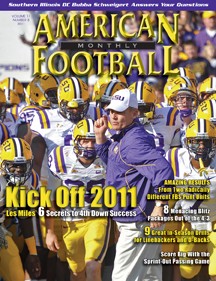Article CategoriesAFM Magazine
|
AFM Subscribers Ask – with Bubba Schweigert, Defensive Coordinator, Southern Illinois Universityby: AFM Editorial Staff© More from this issue Bubba Schweigert enters his fourth season as the defensive coordinator at Southern Illinois University this fall. Since he arrived in Carbondale, the Salukis are 25-11 and last fall led the Missouri Valley Conference in total defense. His philosophy of defense is based on pressuring the quarterback and creating turnovers. Schweigert’s 2009 defense ranked second nationally with 23 interceptions and fourth nationally with 37 turnovers caused. Before joining the SIU staff, Schweigert was the head coach at Minnesota-Duluth. He also coached at the University of North Dakota for 15 seasons, helping them to a Division II National Championship in 2001. Coach Schweigert believes in the 3-4 defense, having taught it for over 20 seasons. “One of the advantages of running the 3-4 system is the ability to remain ba....The full article can only be seen by subscribers.
|
|
|||||||
| HOME |
MAGAZINE |
SUBSCRIBE | ONLINE COLUMNISTS | COACHING VIDEOS |
Copyright 2025, AmericanFootballMonthly.com
All Rights Reserved





